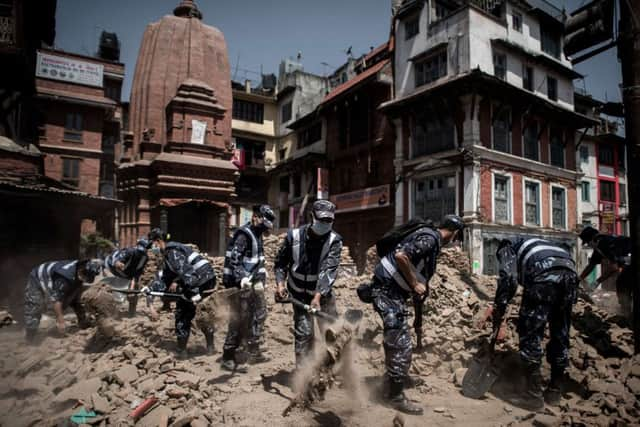Four rescued more than a week after Nepal earthquake


Funchu Tamang was rescued on Saturday and was yesterday in hospital in the Nuwakot district, north-west of Kathmandu, with only minor injuries, police official Arun Kumar Singh said.
He said: “He was brought to the district hospital in a helicopter. His condition is stable.
Advertisement
Hide AdAdvertisement
Hide Ad“He has injuries on his left ankle and hand. His family is with him.”
Three women were also rescued yesterday from rubble in Sindupalchowk – one of the districts which was hit worst by the quake.
One had been buried by a landslide, while the other two were underneath a collapsed building.
Nepal’s government ruled out finding any more survivors in Kathmandu on Saturday.
Rescue teams from more than 20 countries have been using sniffer dogs and thermal-imaging equipment to find survivors, but outside the capital the search is largely being carried out by police officers and the military.
Also yesterday runway damage forced Nepalese authorities to close the main airport to large aircraft delivering aid to millions of people following the massive earthquake, but UN officials said the overall logistics situation was improving.
The death toll climbed to 7,250, including six foreigners and 45 Nepalese found over the weekend on a popular trekking route, said government administrator Gautam Rimal. Nepal’s Tourist Police reported that a total of 57 foreigners have been killed in the 25 April quake, and 109 are still missing, including 12 Russians and nine Americans.
The main runway was temporarily closed to big planes because of damage. It was built to handle only medium-size jetliners, not the large military and cargo planes that have been flying in food, medicines, and rescue and humanitarian workers, said Birendra Shrestha, the manager of Tribhuwan International Airport, located on the outskirts of Kathmandu.
Advertisement
Hide AdAdvertisement
Hide AdThere have been reports of cracks on the runway and other problems at the only airport capable of handling jetliners.
“You’ve got one runway, and you’ve got limited handling facilities, and you’ve got the ongoing commercial flights,” said Jamie McGoldrick, the UN coordinator for Nepal. “You put on top of that massive relief items coming in, the search and rescue teams that has clogged up this airport. And I think once they put better systems in place, I think that will get better.”
He said the bottlenecks in aid delivery were slowly disappearing, and the Nepalese government eased customs and other bureaucratic hurdles on humanitarian aid following complaints from the UN.
“The government has taken note of some of the concerns that we’ve expressed to them,” he said.
Kai Tabacek, a spokesman for Oxfam, said the main problem was that Kathmandu airport was too small “to deal with huge volume of traffic. Of course, there have been some delays, but these have more to do with the challenge of moving large volumes of goods than customs.”
Nepal has been shaken by more than 70 aftershocks.